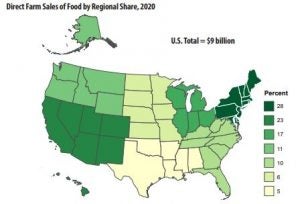Over 147,000 U.S. farms produced and sold food locally through direct marketing practices, resulting in $9.0 billion in revenue in 2020, according to the Local Food Marketing Practices data released by U.S. Department of Agriculture’s National Agricultural Statistics Service. Direct farm sales included both fresh foods and processed or value-added products such as bottled milk, cheese, meat, wine, and jams. However, the number of operations selling locally produced food decreased by 12 percent.
The more than 40,000 farms that sold food directly to institutions and intermediates brought in the most revenue at $4.1 billion; this was followed by operations with direct-to-consumer sales, such as on-farm stores and farmers markets, at $2.9 billion. Sales directly to retailers accounted for $1.9 billion from more than 24,000 operations nationwide.
The top five states by value of total direct food sales were:
- California, $1.4 billion — accounting for 16 percent of the U.S. total
- Pennsylvania, $600 million
- New York, $584 million
- Michigan, $555 million
- Maine, $342 million

Most farms that sold directly to consumers sold through outlets such as on-farm stores. Texas led the nation in the number of farms selling directly to consumers, with almost 8,000 operations engaged in direct-to-consumer sales. California led in sales directly to consumers, earning $284 million.
Data also showed that 78 percent of farms sold their direct-to-market produce exclusively within 100 miles of the farm, while an additional 19 percent sold partially within and beyond 100 miles. The majority (57 percent) of farms marketing food directly were located in metropolitan counties.
Approximately 314,000 people were involved in making decisions for the farms that sold directly to consumers in 2020. Of these, 57 percent were men and 43 percent were women — a higher proportion of women than among all farms, according to data from the 2017 Census of Agriculture. Additional data is available on the survey page or at NASS’s Quick Stats database.


